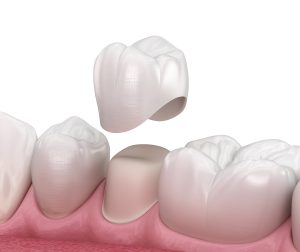

Do You Need a Dental Crown or a Dental Filling?
When it comes to your dental health, monitoring and addressing oral issues is paramount. Restorative dentistry offers many solutions, but how do you know the right choice for you? When it comes to tooth repair, dental crowns and dental fillings are two popular options.
Our Staten Island dentists dive into an insightful comparison dissecting the benefits, costs, and key differences between these restorative procedures. Nothing impacts your smile — or your wallet — like making an informed decision.
What Are Dental Fillings?
Dental fillings are typically used to treat minor tooth decay and damage. They involve removing the damaged portion of the tooth and filling it with a material such as amalgam, composite resin, or porcelain. Fillings are less invasive than crowns as they require minimal removal of tooth enamel, making them a suitable choice for small cavities.
What Are Dental Crowns?
Dental crowns are recommended for more severe cases of tooth damage or decay. Unlike fillings that only cover a small portion of the tooth, crowns encompass the entire visible portion of the tooth above the gum line. They provide strength and protection to teeth that have extensive decay, cracks, fractures, or weakened structures. Dental crowns can restore both the functionality and aesthetics of a damaged tooth.
The Process and Materials for Crowns
The process of getting a dental crown typically involves multiple steps.
- Initially, the dentist assesses the condition of the tooth to determine if a crown is necessary. This assessment includes evaluating the extent of damage or decay and considering factors like tooth location, functionality, patient’s oral health, and preferences.
- The tooth is prepared by removing existing decay and shaping it to accommodate the crown. A portion of enamel may need to be removed to ensure a proper fit. Once enamel is removed, it doesn’t grow back, making this step irreversible.
- Afterward, an impression of the prepared tooth is taken to create a custom-made crown that fits perfectly. With advancements in technology, same-day crowns using CAD/CAM systems have become popular. These CEREC crowns are made from ceramic or porcelain that matches the color of natural enamel.
- Once the crown is created, it’s securely bonded onto the prepared tooth using dental cement or adhesive. The fitting is checked to ensure optimal bite alignment and comfort. The entire process aims to restore both function and aesthetics while providing long-term durability.
The Process and Materials for Fillings
When it comes to treating tooth decay and minor damages, dental fillings are often the go-to option. The process for getting fillings is relatively simple and minimally invasive compared to dental crowns.
- Your dentist begins by numbing the area around the affected tooth using a local anesthetic to ensure a pain-free procedure. Once numbness sets in, the dentist will remove the decayed or damaged portion of the tooth using a drill or laser.
- After removing the decayed portion, your dentist will clean the area thoroughly to remove any remaining debris or bacteria.
- Once cleaned, your dentist will apply a filling material to restore the tooth’s structure and functionality. The type of material used for fillings can vary, but composite resin is commonly used for visible teeth due to its ability to match the color of natural enamel seamlessly.
Comparing Durability and Performance
Dental crowns and fillings differ significantly when it comes to durability and performance.
- Dental fillings are suitable for treating minor tooth decay and damage when there’s a substantial amount of healthy tooth structure remaining. They seal off cavities and prevent further decay. However, with larger fillings, there may be an increased risk of fracturing over time due to regular biting forces.
- Dental crowns offer superior strength and protection due to their full coverage of the visible portion of the tooth above the gum line. Crowns are recommended for severely damaged teeth or after extensive decay removal. They serve as a protective shield, restoring the tooth’s natural strength and preventing further damage. The materials used for dental crowns, such as ceramic or porcelain, can match the color of your natural enamel, ensuring an aesthetically pleasing result.

Costs of Crowns and Fillings
The cost of dental crowns and fillings can vary depending on several factors, such as the material used, the location of the affected tooth, and the complexity of the procedure. Generally, dental fillings are more affordable compared to dental crowns.
You’ll want to consider the long-term implications and potential consequences. While fillings may initially seem like a cost-effective solution, they may not be as durable as dental crowns. Crowns provide superior strength and protection for weakened teeth, which can potentially reduce the need for future extensive treatments and expenses.
For instance, if you opt for a filling for a cracked tooth without addressing the underlying structural issues, it may lead to further damage over time, requiring additional treatments such as root canals or even extraction. In contrast, a crown placed on a compromised tooth provides added reinforcement and can prevent future complications.
Additionally, dental insurance coverage should be taken into account when evaluating costs. Some insurance plans offer partial coverage for crowns and fillings, while others may have limitations or exclusions. Consulting with your dentist and insurance provider will help you understand your coverage options and financial responsibilities.
Factors Influencing Treatment Selection
When it comes to choosing between dental crowns and dental fillings, several factors come into play.
- The extent of tooth damage or decay: Dental fillings are recommended for minor cases of tooth decay, where the damage is limited to a small portion of the tooth. On the other hand, dental crowns are typically used to treat severely damaged teeth that have significant decay or structural issues.
- The location and visibility of the affected tooth: Fillings are often preferred for visible teeth as they can be color-matched with natural enamel, blending seamlessly with the surrounding teeth.
- Patient-specific factors: Age is a consideration, as younger patients may require restorations that accommodate changes in jaw growth and development over time. For older patients, the strength and longevity of the restoration become critical factors. In terms of overall health, patients with certain medical conditions or compromised immune systems may have unique dental needs that guide treatment decisions.
- Lifestyle habits: Certain habits, like teeth grinding or clenching, can exert excessive force on the teeth. Patients who engage in these habits may be more prone to tooth fractures or damage, indicating a higher likelihood of dental crowns. On the other hand, individuals with good oral hygiene practices and minimal risk factors may be suitable candidates for dental fillings if the extent of damage allows for it.
Call Today for a Consultation!
Do you need restorative dental work? Are you unsure what treatment is best for you? Contact our Staten Island dentists today to schedule your consultation. Our dentist will discuss dental fillings and dental crowns and recommend the treatment that best suits your needs.



